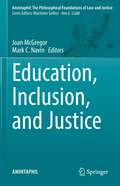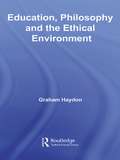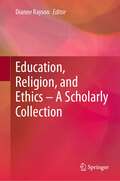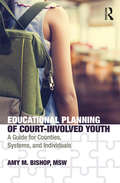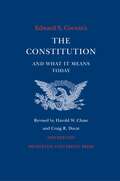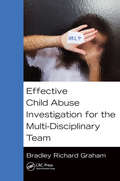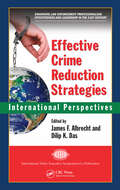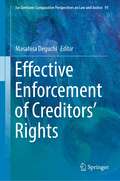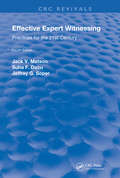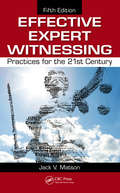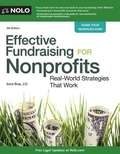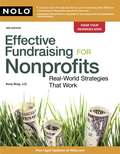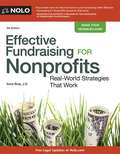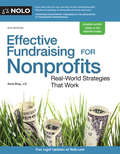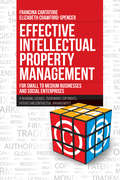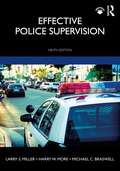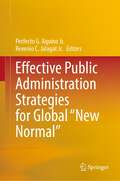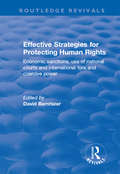- Table View
- List View
Education, Inclusion, and Justice (AMINTAPHIL: The Philosophical Foundations of Law and Justice #11)
by Mark C. Navin Joan McGregorThis book approaches education as a vital human good, both because it fosters the development of intellectual, moral and civic virtues, and because it promotes the development of valuable skills for work and for life. Accordingly, debates on justice, democracy, equality and inclusion often focus on questions concerning the kind of education people should receive, how scarce educational goods should be distributed, and the role of education in responding to historical and ongoing injustices. This volume collects 16 new essays that explore these pressing ethical, political and legal issues.
Education, Philosophy and the Ethical Environment (Foundations and Futures of Education)
by Graham HaydonHow much can we reasonably expect from education? This book, written by a philosopher of education, casts new light on this question by seeing values education, not as a separate activity within schools, but as an aspect of education that both reflects the surrounding climate of values and can help to change it. Graham Haydon argues that all of us – whether as teachers, parents, students or citizens – share in a responsibility for the quality of that ethical environment. He argues that we must ensure that what happens in schools will: enable young people to appreciate the diversity of our ethical environment help them find their way through its complexities contribute to developing a climate of values that is desirable for all. This book shows that values education is too demanding to be left to parents and too important to be entrusted to government initiatives. For teachers engaged in values education, this book brings a fresh perspective to what they are doing, within a realistic view of their responsibilities. For students of education, it shows that practical issues can be illuminated by insights from philosophy.
Education, Religion, and Ethics – A Scholarly Collection
by Dianne RaysonThis collection draws on research in educational areas displaying best practice pedagogy, theoretical and practical, underpinned by philosophy, empirical science, and neuroscience, among other disciplines. It focusses especially on implications for higher education, school education, professional ethics, and religion. Higher education exploration is on the diminution of the humanities and implications for the range of knowledge needed for future citizenship. The work includes a revisioning of higher education’s purpose, especially the changing role of the doctorate and its examination. The focus on school education takes the same pedagogical lens to humanities and social sciences, examining values education and religious studies. Ethical issues include colonisation and decolonisation, especially around the concept of land and ramifications for intercultural studies. The ethics and practice of teaching about life and death issues in medical education are explored in light of research in dialogic consensus. The religion section includes research on interfaith education, especially concerning Islam, and eco-theological education, especially focussed on climate change. Contributors are academic colleagues or former doctoral students of Terence J. Lovat (University Professor, Australia, UK, and Canada) whose internationally acclaimed research straddles these areas. Many of the contributors hold positions of influence in the academic or professional world, while others bring their newly minted doctoral research to the content.The intended readership includes academics and doctoral students across education, ethics, religion, social studies, ecology, health and medicine, indigenous studies, and international affairs.This collection, published in honour of Emeritus Professor Terence Lovat, provides rich insights into the scope and multidisciplinary depth of his scholarship. A philosopher of education whose main work has centred on curriculum theory and values education and ethics in education, Lovat’s scholarship reminds us that the education of children and young people must be concerned with more than academic attainment. In emphasising education as a holistic and moral endeavour—one involving hearts and minds—Lovat has consistently advocated for the provision of opportunities for young people to extend their horizons beyond the school environment to engage with issues in society that go beyond academic learning. Professor Lovat has also made a major and longstanding contribution to the development of Studies of Religion in schools and to the theology and history of Islam and Islamic Education. In traversing Lovat’s significant and remarkable contributions to education, religion and ethics, and the links between them, this book serves as a testament to a highly esteemed scholar.Associate Professor Deborah Henderson, Queensland University of Technology, Australia
Educational Equity (Gender and American Law: The Impact of the Law on the Lives of Women)
by Karen J. MaschkeMultidisciplinary focus Surveying many disciplines, this anthology brings together an outstanding selection of scholarly articles that examine the profound impact of law on the lives of women in the United States. The themes addressed include the historical, political, and social contexts of legal issues that have affected women's struggles to obtain equal treatment under the law. The articles are drawn from journals in law, political science, history, women's studies, philosophy, and education and represent some of the most interesting writing on the subject. The law in theory and practice Many of the articles bring race, social, and economic factors into their analyses, observing, for example, that black women, poor women, and single mothers are treated by the wielders of the power of the law differently than middle class white women. Other topics covered include the evolution of women's legal status, reproduction rights, sexuality and family issues, equal employment and educational opportunities, domestic violence, pornography and sexual exploitation, hate speech, and feminist legal thought. A valuable research and classroom aid, this series provides in-depth coverage of specific legal issues and takes into account the major legal changes and policies that have had an impact on the lives of American women.
Educational Planning of Court-Involved Youth: A Guide for Counties, Systems, and Individuals
by Amy BishopEducational Planning of Court-Involved Youth provides a framework for alleviating chronic barriers for youth in the child welfare and juvenile justice systems. This guide combines best-practice recommendations from national research with direct service tactics employed successfully in multiple counties. Included are the necessary components to implement a collaborative, community-centered intervention system that meets the needs of the county, family, and individual. With the understanding that each county carries its own strengths, barriers, and resources, these tools serve as a model for assessing and adapting the system to cater to the unique needs of each area in which it is implemented. This text helps facilitate the coordination and collaboration necessary to foster comprehensive systems and individualized planning for youth.
Educational Policy and the Law
by Rachel Moran James E. Ryan Betsy Levin Kristi L. Bowman Mark G. YudofThis comprehensive casebook presents thorough coverage of a complex and dynamic subject--educational law and policy in the elementary and secondary school setting. With an emphasis on the interplay between law and policy, legal decisions, and educational practice, the book's interdisciplinary approach provides a wide range of perspectives on the most pressing issues in the field. Cases, legislation, and articles, all of which are accompanied by notes and discussion questions, clarify the issues and bring them to life. The book draws upon a range of social science sources as well as conventional legal materials, offering analyses that provide insights into the political and policy contexts of legal issues, and helping readers make sense of legal decisions. The abundant notes and references also make the book a useful reference work for lawyers or school administrators working in the field.
Educational and Cultural Challenges of the European Sustainability Model: Breaking Down Silos in the Legal Domain
by María Dolores Sánchez GaleraThe book provides a comprehensive overview of the European Sustainability Model which cannot be properly understood without taking into account the global governance trends surrounding the topic. The author offers a fresh analysis of both theory and praxis of sustainable development in the open-ended process of EU integration by shedding new light on the often-overlooked role that law and legal science should have within the educational and cultural domains. The monograph explores the necessity of new conceptual and methodological approaches in order to understand the emerging educational and cultural challenges when it comes to their integration and intersection with sustainability in today’s society, which desperately claims systemic transformations.
Edward S. Corwin's Constitution and What It Means Today: 1978 Edition
by Edward S. CorwinFor over seventy-five years Edward S. Corwin's text has been a basic reference in the study of U.S. Constitutional Law. The 14th edition, the first new edition since 1973, brings the volume up to date through 1977.In this classic work, historian Edward Corwin presented the text of the U.S. Constitution along with his own commentary on its articles, sections, clauses, and amendments. Corwin was a renowned authority on constitutional law and jurisprudence, and was hired at Princeton University by Woodrow Wilson in 1905.Far from being an impersonal textbook, Corwin's edition was full of opinion. Not afraid to express his own strong views of the development of American law, Corwin offered piquant descriptions of the debates about the meaning of clauses, placing recent decisions of the court "in the familiar setting of his own views." The favor of his style is evident in his comments on judicial review ("American democracy's way of covering its bet") and the cabinet ("an administrative anachronism" that should be replaced by a legislative council "whose daily salt does not come from the Presidential table").Corwin periodically revised the book for nearly forty years, incorporating into each new edition his views of new Supreme Court rulings and other changes in American law. Although Corwin intended his book for the general public, his interpretations always gained the attention of legal scholars and practitioners. The prefaces he wrote to the revised editions were often controversial for the views he offered on the latest developments of constitutional law, and the book only grew in stature and recognition.After his death in 1963, other scholars prepared subsequent editions, fourteen in all.
Effective Child Abuse Investigation for the Multi-Disciplinary Team
by Bradley Richard GrahamChild abuse cases are unique in that they involve seldomly witnessed acts. A nonverbal victim and a silent perpetrator will often lead to a stalling of the investigation and the judicial process. Effective Child Abuse Investigation for the Multi-Disciplinary Team is a practical guide for law enforcement officers and child protection workers in abus
Effective Crime Reduction Strategies: International Perspectives (International Police Executive Symposium Co-Publications)
by Dilip K. Das James F. AlbrechtThe International Police Executive Symposium (IPES, www.ipes.info) coordinates annual international conferences to evaluate critical issues in policing and recommend practical solutions to law enforcement executives deployed across the globe. Drawn from the 2005 proceedings hosted by the Czech Republic in Prague, Effective Crime Reduction Strategie
Effective Directors: The Right Questions to Ask (QTA) (Questions to Ask (QTA))
by Charlotte ValeurThe ebook will be Open Access and made available on publication. Being a good board member is not about knowing everything; it is about asking the right questions and challenging appropriately. Effective Directors: The Right Questions To Ask (QTA) is a reference book for board members and executives globally to support them in their work. With chapters written by senior company board members and respected figures in corporate governance, the questions have been drawn together to offer food for thought and useful prompts that take boards beyond operational discussions. The book clearly presents key areas to be considered by the board (there are over 50 in total) and range from board composition, to data security, diversity and inclusion, and succession planning. The questions are ones that boards, in any organisation, should be asking themselves, their fellow board members, service providers, executives, and other stakeholders to ensure that the right issues are raised, transparency and effective oversight are achieved, and the board is fulfilling its role in governing the organisation. In addition to being invaluable for board members, the book is also a very useful tool for executives in understanding the kind of questions their board members are likely to ask, and the kind of questions that should be asked and discussed in the boardroom.
Effective Enforcement of Creditors’ Rights (Ius Gentium: Comparative Perspectives on Law and Justice #91)
by Masahisa DeguchiThe problem of enforcing a money judgment exists in every legal system in the world, but the methods and orientation vary significantly. Effective enforcement proceedings are crucial to ensure full access to justice for creditors. Complete and full knowledge of the debtors’ assets is crucial to choose the appropriate enforcement measure. But each legal system must balance the creditors’ rights to an efficient enforcement with the debtors’ rights. The wide differences between enforcement proceedings mirror the way each society tries to find a balance between confronting rights and interests.This book explores and compares how different legal systems approach these issues with a focus on the discovery of debtors’ assets, which is a common problem for enforcement and execution proceedings in almost every jurisdiction. This is the first book to compare enforcement proceedings around the world and presents a variety of information and country reports from leading experts from four continents. It represents the joint work of academic and legal authorities from Germany, Japan, Korea, France, the UK, Switzerland, Austria, Spain, Poland, Russia, Greece, North America, Taiwan, Brazil, Argentina, Chile, and the EU.
Effective Environmental Assessments: How to Manage and Prepare NEPA EAs
by J. Peyton Doub Charles EcclestonAlthough upwards of 50,000 Environmental Assessments (EA) are prepared annually, the focus of the National Environmental Policy Acts (NEPA) Regulations is clearly on defining requirements for preparing environmental impact statements. Surprisingly, until now, there has been no authoritative and comprehensive guide on how to prepare Environmental As
Effective Environmental Regulation in China: Reflections on the Experience of European Union Legislation on Environmental Permits (The Rule of Law in China and Comparative Perspectives)
by Federico PasiniThough recently improved, Chinese legislation on environmental permits is still weak and urgent measures are needed to help the country in moving towards an effective permitting system. This book examines this legislation gap and presents a contribution to solving China’s pollution problems. By analysing the deficiencies of current Chinese provisions on permitting in light of EU legislation, and its Italian application, the book determines which permitting legislative structure and approach China should embrace in practice in order to build more comprehensive legislation on emission permitting. It is argued that a set of ad hoc legislative measures should be implemented so as to strengthen China’s environmental protection and efficiently tackle pollution. The book will be a valuable resource for researchers, academics and policy-makers working in the areas of international environmental law and comparative law.
Effective Expert Witnessing, Fourth Edition: Practices for the 21st Century (Routledge Revivals)
by Jack V. Matson Suha F. Daou Jeffrey G. SoperFirst Published in 2004: Effective Expert Witnessing, Fourth Edition broadens the scope of previous editions by featuring case studies and examples from a wide range of disciplines including psychology, medicine, forensics, toxicology, engineering, and environmental science. It presents legal survival strategies needed by expert witnesses in all fields by addressing the impact of the recent rulings regarding expert testimony.
Effective Expert Witnessing: Practices for the 21st Century (Routledge Revivals Ser.)
by Jack V. Matson S. Ravi JagannathanThe testimony of an expert witness can lead to success or failure in cases that hinge on the presentation‘s impact on a jury. Effective Expert Witnessing, Fifth Edition: Practices for the 21st Century explores the fundamentals of litigation, trial preparation, courtroom presentation, and the business of expert witnessing. Extensively updated to ref
Effective Fundraising for Nonprofits
by Ilona BrayGetting tax exempt status for your nonprofit organization is just the first step toward succeeding in your mission ultimately, your nonprofit's effectiveness depends entirely on your ability to raise money. Effective Fundraising for Nonprofits will show you how. Featuring advice and stories from over 40 experienced fundraisers, foundation staffers, journalists, and more, this edition of Effective Fundraising for Nonprofits offers strategies for raising donations from individuals, companies, and institutions, and covers the tools and staff you'll need to get the job done. Find out how to: -work with individual donors -analyze the donor base -plan special events -solicit grants from foundations and corporations -get media coverage -use the Web to further fundraising goals -start a side business to raise funds Best of all, Effective Fundraising for Nonprofits contains expert advice written in plain English, cutting out the jargon and "consultant speak" that's all too common in many nonprofit books. The new edition covers the latest wisdom on online fundraising, including using social networking for fundraising and tips on dealing with the down economy. And you can read up on latest studies on who gives the most and why and the latest tips for "greening" your nonprofit's special events. Plus, you'll get the latest tax figures, guidelines for the new IRS Form 990, and updated resource recommendations and contact information.
Effective Fundraising for Nonprofits
by Ilona Bray J.D.Getting tax-exempt status for your nonprofit organization is just the first step -- whether its mission will succeed depends entirely on your ability to raise money. Fortunately, Effective Fundraising for Nonprofits will show you how. Featuring advice and stories from over 40 experienced fundraisers, foundation staffers, journalists and more, the 2nd edition of Effective Fundraising for Nonprofits explains how to: work with individual donors plan special events solicit grants from foundations and corporations get media coverage use the Web to further fundraising goals start a side business to raise funds and much more The 3rd edition is updated to reflect the latest studies on who gives the most and why. It also contains new tax figures, the new IRS Form 990, updated resource recommendations and contact information and offers tips for "greening" one's special events.
Effective Fundraising for Nonprofits: Real-World Strategies That Work
by Ilona BrayGetting tax-exempt status for your nonprofit organization is just the first step toward succeeding in your mission -- ultimately, your nonprofit's effectiveness depends entirely on your ability to raise money. Effective Fundraising for Nonprofits will show you how. Featuring advice and stories from over 40 experienced fundraisers, foundation staffers, journalists, and more, this edition of Effective Fundraising for Nonprofits offers strategies for raising donations from individuals, companies, and institutions, and covers the tools and staff you'll need to get the job done. Find out how to: work with individual donors analyze the donor base plan special events solicit grants from foundations and corporations get media coverage use the Web to further fundraising goals start a side business to raise funds Best of all, Effective Fundraising for Nonprofits contains expert advice written in plain English, cutting out the jargon and "consultant speak" that's all too common in many nonprofit books. This easy-to-read book combines the author's legal and fundraising experience with advice and stories from over 50 experienced fundraisers. Offers practical guidance on all the forms of fundraising that a new or small to mid-size nonprofit will need, including working with individual donors, planning special events, soliciting grants from foundations and corporations, getting media coverage, using the Web and social media, and much more. Includes handy worksheets and sample letters.
Effective Fundraising for Nonprofits: Real-World Strategies That Work
by Ilona BrayJump start your fundraising efforts! Whether your nonprofit has just gotten tax-exempt status or has been operating for years, its success or failure depends on its ability to raise donations from individuals, companies, and institutions. The question you’re facing is, “How do we make our voices heard and bring in the needed support?” Here, you’ll find plain-English answers. Featuring advice and stories from over 50 experienced fundraisers, foundation staffers, journalists and more, this book explains how to: make a fundraising plan work with individual donors keep givers giving plan special events solicit grants from foundations and corporations use traditional and social media to engage supporters start a side business to raise funds and much more. Effective Fundraising for Nonprofits also provides creative grassroots strategies and dozens of real-life success stories. Best of all, it cuts out the jargon and “consultant speak” that’s all too common in nonprofit books. The 6th edition is completely updated with new stories and samples, the latest IRS rules and regulations, and the latest communication strategies.
Effective Intellectual Property Management for Small to Medium Businesses and Social Enterprises: IP Branding, Licenses, Trademarks, Copyrights, Patents and Contractual Arrangements
by Francina Cantatore Crawford-Spencer ElizabethIntellectual property (IP) management is an area of corporate management that has often been neglected or overlooked by small and medium size businesses, and even more so by smaller third sector enterprises, despite the fact that effective IP management strategies can make the difference between the success and failure of an organization. This book focuses on ways in which small and medium size enterprises - including social enterprises - can protect and manage their IP.°A valuable resource for any legal practitioner dealing with IP law and commercial law areas, this book explains the importance and value of IP, including patents, trademarks, copyright, branding and licenses, and provides insight into day-to-day challenges faced by smaller businesses and social enterprises. It also includes useful discussions on vital aspects of IP, such as using IP as security, IP branding, franchising models and contractual arrangements.°Drawing on qualitative research conducted in Australia and identifying the unique challenges faced by third sector SMEs, the book offers practical strategies for effective IP management and protection. Its functional and up-to-date approach on IP related issues for small and medium size businesses and not-for-profits distinguishes this work from others in the field of IP rights management.
Effective Police Supervision
by Larry S. Miller Harry W. More Michael C. BraswellEffective Police Supervision, 9th ed., is a time-tested text providing complete coverage of the organizational dynamics surrounding leadership of teams in an effective police department. This revised edition provides readers with the tools to excel and advance with up-to-date and timely scholarly research and legal case law on supervision. Special attention is given to recruitment, selection, and retention of police, commonly believed to be the most challenging internal issue facing agencies today. Supervisory tactics are evaluated in terms of how they work not only in the United States but in the United Kingdom and Canada as well, and chapters are enhanced with boxed features that help the reader connect ideas with realistic situations. Combining behavioral theory and updated case studies, Effective Police Supervision is the preferred textbook for college-level classes on police supervision and is an essential resource for preparation for promotional exams and career development for law enforcement officers and supervisors. Information has been included to respond to current issues facing law enforcement with Covid-19 and managing protests.
Effective Policing for 21st-Century Israel
by Robert C. Davis K. Jack Riley Claude Berrebi Steven W. Popper Andrew R. Morral Jessica Saunders Kristin J. Leuschner Shira Efron Boaz SegalovitzIsrael has changed dramatically in the past two decades. The Israel Police is transforming itself to meet the needs of modern Israel. The Ministry of Public Security, the Ministry of Finance, and the Israel Police asked RAND to conduct a study to address issues of public perceptions and trust in the police, benchmarking the police against other police organizations, performance measurement, and deterrence and crime prevention.
Effective Public Administration Strategies for Global "New Normal"
by Perfecto G. Aquino Jr. Revenio C. Jalagat Jr.This book analyzes the recent discussions on the practices, issues, challenges and strategies of various public organizations and service organizations in light of the ongoing global pandemic. The book investigates how such organizations have managed to sustain the changes brought on to operations due to the new normal business environment and, in doing so, provides lessons and insights on how similar strategies could be implemented successfully in other organizations. This book would be a valuable read for policy makers, decision makers of public organizations, and scholars.
Effective Strategies for Protecting Human Rights: Economic Sanctions, Use of National Courts and International fora and Coercive Power (Routledge Revivals)
by David BarnhizerThis title was first published in 2001: This book brings together the experiences of a diverse range of leading human rights advocates and activists to demonstrate strategies for protecting human rights. The volume identifies strategic problems and approaches and offers a range of strategies that hold promise for sanctioning human rights offenders and for inhibiting the behaviour of those who might otherwise engage in such activities. The contributors include, inter alia, Noam Chomsky, Justice Richard Goldstone of the Constitutional Court of South Africa who served as Chief Prosecutor of the UN War Crimes Tribunals for the former Yugoslavia and Rwanda, and David Rawson, United States Ambassador to Rwanda during the tragic genocide. Those who work in the disparate field of human rights increasingly understand the need to see the system strategically rather than piecemeal. This volume captures their insights and looks at both private and public actors, including the uses and limitations of international fora to prosecute violations. The focus is expanded to include private actions because political issues too often interfere with enforcement of human rights laws - allowing violators to hide behind the unwillingness of national governments to take action.
